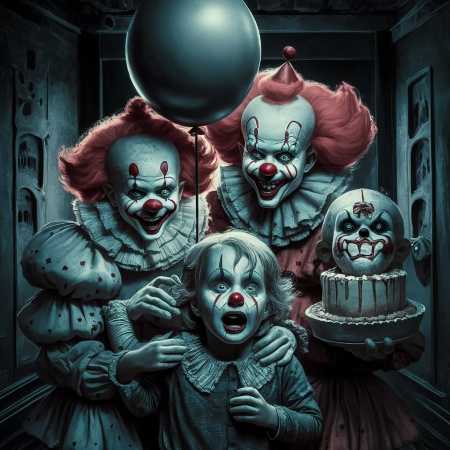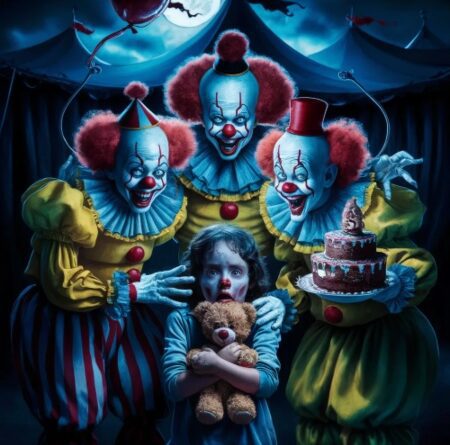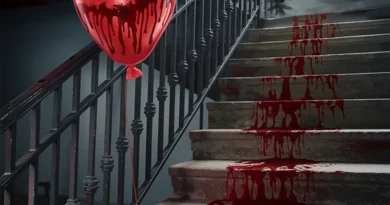Fear Of Clowns Is NOT A Joke. Can Horror Films Cause It?
When you hear the word “clown,” what do you think? Many people will associate clowns with happy birthdays, cheerful songs, and slapstick jokes ranging from silly to entertaining. For horror fans, on the other hand, clowns bring up completely different connotations: it is enough to remember characters of gruesome clowns that we have encountered, such as Pennywise (“It”), Art the Clown (“Terrifier”), and others. The truth is that you don’t have to like horror movies to be afraid of clowns. The fear of clowns, also known as Coulrophobia, is a phenomenon that exists in all ages and may affect the behavior of those who suffer from it in different ways. We may ask how horror movies are related, and can we see them as a cause, trigger, or part of the solution?
Coulrophobia Is Not A Joke
The first question we may ask is what is the fear of clowns? The American psychiatric diagnostic book, the DSM-IV, is the first source you should check to define phobias. In this case, we are likely to find that the phenomenon of fear of clowns is unique. The book doesn’t officially express the fear (in fact, the term “Coulrophobia” isn’t official either) but primarily refers to it within the broader world of fear of costumed characters. We indeed can find this fear in the list of anxiety disorders. However, we note in advance that the research on the subject is minimal, and even a study that was cited many times on the issue turned out to have technical problems, which caused the researchers to retract it. The truth is that it is not certain that academic definitions change too much.

We do not claim to be experts in psychology and the human soul. Still, it is possible to claim that the fear of clowns, which sometimes reaches the level of phobia for anything and everything, may cause adverse effects on both the body and the mind. The phobia may manifest in unpleasant external symptoms such as increased heart rate, difficulty breathing, tremors, nausea, vomiting, or dizziness. It may cause behavioral changes. Even though we don’t encounter a clown every day (indeed not a clown with a scary face), for people who suffer from extreme anxiety, even an innocent image of a clown or the thought of him can be a trigger for fear. For them, Purim is not a holiday but a nightmare, and there are quite a few stories about popular horror films that intensify the fear.
It is no joke, even if some people see the fear of clowns as an anecdote. If the fear is prolonged, extreme, does not match the situation, and/or leads to intense physical symptoms, which may cause distress and avoidance – we cross the line between fear and clowns and phobia. That line may be thinner than people think. Along with the Coulrophobia symptoms, The fear is that people who suffer from a fear of clowns will change their behavior to avoid any possible encounter with a clown: from the tap at birthday parties to avoiding mass events that may include clowns, for example, Halloween parties.
The moment when anxiety causes a behavioral change, even if at first glance it is not so extreme (it is not that every given day we are expected to meet a clown on the street), is the moment when we realize, in many cases that there is a serious problem here that requires treatment.
💀 Killer Deals & Scary Recommendations 💀
🎭 Costumes & Accessories
HalloweenCostumes Fun Costumes Entertainment Earth
🛒 Online Shopping
AliExpress Amazon Walmart Etsy
🧛 Collectibles & Horror Brands
Funko Hot Topic Lego Spirit Halloween
🎢 Attractions & Tours
GetYourGuide Tiqets Viator Klook
📖 Blogs & Horror Sites
Bloody Disgusting iHorror Fangoria
🩸 Disclaimer: Some links are affiliate links. The price stays the same – it just helps keep the site alive 👻
Where Did The Fear Of Clowns Originate?
Without going too much into the Psychology behind fear of clowns, it is easy to understand why many people fear clowns. Fear, at its core, is created in most cases when we encounter a “normal” object but with a “twist” that makes it foreign (zombies and ghosts, for example, look a bit like humans but are also very different from them). Clowns are known for their colorful clothing, heavy makeup (did someone say red nose?), and faces that are supposed to be funny, but all of these express a specific deviation from the character we are used to seeing.
Turning to an unfamiliar area in appearance or behavior (many clowns choose not to speak or speak in a strange language) can cause fear or even natural anxiety in many. This is also why children may be more likely to develop a fear of clowns than adults, who are likely to have encountered quite a few clowns in their lives on screen, at birthdays, and so on.
Like many other fears, past experiences and traumas we suffer may also develop a phobia of clowns at some point. Think, for example, of children who remember a clown costume that startled them a little, were afraid of a visit to the circus (which has a lot of scary elements, such as dangerous stunts, fire, lions, etc.), or even remember very well a particular action or a birthday party that went wrong. If you also grew up on “Buffy the Vampire Slayer,” you may remember the charming Xander. In the tenth episode of the first season of the series, Nightmares, we find out that Xander has a fear of clowns, which stems from his childhood memory: at his birthday party at the age of six, a clown chased him, and he got scared until he had an embarrassing accident. Then in one of the episodes, he confronts a murderous clown chasing him with a knife. He is facing his childhood fear here.
The fear may be present in the case of children, in whom the cognitive abilities that allow separation between reality and fiction are not sufficiently developed. Still, the fear may intensify or even develop even in adulthood. At this point, horror movies and TV series come into play, which can undoubtedly be considered responsible to some extent for creating the image of the scary clown. But the relationship between them is not simple and unequivocal.

The Clowns That Can Create Fear
One of the primary debates in the media is about its possible effects. Suppose we analyze the fear of clowns according to the uses and gratifications approach. In that case, we can ask one crucial question: Is someone who is exposed to the image of a horrible clown in the media likely to develop fear as a result, or is he drawn to the fear of clowns from the beginning and that is what made him sit in front of this fictional text in the first place? Discussions of this kind cannot give us an unequivocal answer, so it is better to stick to the facts on the ground.
You don’t have to be a movie expert to know some popular horror movies about clowns. The most familiar character is, as we already hinted before, Pennywise. The murderous clown from the book by Stephen King, the miniseries about him from the 90s, and the two films from the last years (“It” from 2017 and “It: Part 2” from 2019) is one of the biggest icons of horror. The brilliant representation of Bill Skarsgård and the successful makeup brought Pennywise back to life. There is a huge demand today for merchandise based on this new representation of Pennywise. These films are undoubtedly a huge success: both ranked in the top five of the highest-grossing films, and the first “It” movie is the most successful horror film ever.
There are many other clown characters. We mentioned in our review that Art the Clown, from the “Terrifier” film series, could very well be the next great horror icon: in this case, you won’t find a clown here in many colors, but mainly in pure black and white, but he is no less scary. The repertoire of clowns in the world of horror includes, among other things, that suffocating clown doll from Poltergeist (which we included in the list of creepy dolls in horror films), Twist the Clown from “American Horror Story,” Captain Spaulding from “The House of 1,000 Corpses” – and the list goes on. We are sure that shortly, we will sort out all the prominent clown characters and the horror movies that put a clown at the center, but in the meantime, here is a video that will give you a taste of some of the scariest clown characters in the cinema.
Horror Movies And Fear Of Clowns: Pretty Complex Connection
Is the appearance of scary clowns in horror movies harmful? The truth is that this question requires a whole, even philosophical, discussion. On the one hand, some would argue that the film may perpetuate fear or create new fears, which may affect reality.
The scary clown phenomenon of the previous decade is a prime example, especially the silly fear of clowns pranks. In these years, in various countries around the world, people – mainly young people – began to dress up as clowns, ambush people in crowded or deserted places (from a street, through a school to a forest), intimidated them and in some cases even attacked or created the impression of an attack: using a knife Or with a chainsaw, for example. There were cases when these “prankish” intimidations crossed the boundaries of good taste, to the point of arresting the “clowns” on charges of intimidation, threats, or assault.
On the other hand, people began to attack those dressed as clowns, even for innocent purposes such as medical clowning, which has already been proven to have significant changes in the therapeutic process of many, especially children. This phenomenon spread with the arrival of the movie “It” on the screens and its huge success, until there were claims that it was abetted by the PR campaigns of “It” or the movie “31” by Rob Zombie, in which some of the villain characters are evil clowns.
As far as we know, these claims are not accurate, even if it is possible that someone in the production rubbed their hands with pleasure following these phenomena, increasing the already vast hype around these films.
An in-depth discussion is necessary to understand whether horror movies can develop fears of phobias. Quite a few studies were made on the subject, and the results are far from unequivocal. In most cases, even if a horror film is scary and startles us – at some point, we are expected to understand that it is a film, so the fears should pass after it ends (we are not referring to an extreme case where the film accompanies a particular person even weeks or months after viewing).
Fears, especially phobias, are more complex and more profound situations that go far beyond the limits of the screen. However, some studies indicate that the appearance of scary clowns in documentary content, including horror films, may increase the percentage of people who experience fear and phobias of clowns.

On the other hand, horror films, by their very essence, can confront us with our fears. We watch movies in the safe environment of the television or cinema screen. If the viewer sees the character of the clown from a safe distance and learns how the protagonists manage to deal with them – sometimes the film ends with a happy ending, in which they tend to defeat the villain – there can be a certain sense that his dealing with personal fears will be more successful. It is clear, however, that many research studies need to be carried out to see if horror films can be a therapeutic tool against fears and phobias in general, and fears of clowns and costumed characters in particular.
Even Children’s Content Has Scary Clowns
One might have expected that the topic of clown phobia would be exclusively associated with horror movies and series, but like many other fears: you can find references to them, and sometimes also horrifying scenes, in a long line of texts, including those intended for the young audience.
One of the most impressive points in Pixar’s masterpiece “Inside Out” is that it is also a brilliant, deep, and complex film for adults. Sure, it’s an animated movie. Still, it addresses psychological issues, including references to movies that it’s hard to believe the kids know (for example, the glowing reference to Roman Polanski’s “Chinatown”). One of the scenes is a dream of the girl Riley, which quickly turns into a nightmare. In the dream, her feelings run into a clown puppet named Jangles, portrayed in the most menacing way possible. At the beginning of the scene, he is asleep, and the emotions are careful not to wake him. When it does happen – because it’s hard to keep toys quiet – he is presented in the most threatening way possible, with a twisted smile, creating destruction in every corner.
One of the most important representations of a clown in recent years, probably following the breathtaking performances of the late Ledger in “The Dark Knight” and Joaquin Phoenix in “Joker,” both of the supervillain and the scary clown known as “Joker” from the Batman movies and the broader world of DC. The Joker is not only a horrifying character in his behavior and appearance but a mass murderer and shameless psychopath who ranks at the top of every list of the greatest movie villains ever. Over the years, several versions have explained how the Joker became this way: from the fall into a tank of chemicals and a nervous breakdown to a neurological disorder and complex life circumstances.
You can find references to the fear of clowns in countless other “friendly” content, such as “Seinfeld,” “Frasier,” “Modern Family,” “One Tree Hill,” “Doctor Who,” “Animaniacs,” “Boston Legal” and others. In the fifth season of “One Tree Hill,” Jamie’s grandmother invites a clown to his birthday and has to face Haley, who is afraid of clowns and makes every effort to avoid meeting him on the birthday. In “Seinfeld,” to take another example, we learn that Kramer has a fear of clowns, and of course, to create a comic scene, he meets a clown who confronts him with it.
The contrast between what the clown is supposed to represent positively and what it means for certain people who suffer from this fear may cause a conflict that the average viewer defines as comical. Scenes of this type are harmless, sometimes even amusing, but they can certainly raise awareness issues. One of the prominent roles of the media in general, and cinema and television in particular, is to draw our attention to problems we don’t always know or want to admit to: We don’t really know exactly how common is the fear of clowns.
Recent polls indicate almost half of the population we afraid of clowns in some capacity, and in fact: more people are afraid of clowns than climate change, terrorism and even death. Maybe we are exaggerating a bit, but we can say that if, following such a fictional text, one person realizes that he suffers from a common problem that he can treat, then that text has done its job.
How Can We Overcome Fear Of Clowns?
As with other types of fears and phobias, the first step in dealing with a fear of clowns can be simply admitting that there is such a fear or at least getting tested on the subject if you feel symptoms that can be attributed to the fear. Dealing with this fear is not a simple task because some people feel embarrassed to admit that they suffer from the anxiety that its object is so “innocent” or childish. The environment’s reactions to fears of this type can be uncontainable to the point of being offensive, so the immediate environment can also be part of the solution and increase it from the second past. Occasionally, articles that present the fear and its legitimacy to the general public are published, but it is not always enough.
This website does not pretend to provide psychological information or individual advice but to present a phenomenon that can be linked (directly or indirectly) to one of the common images from horror films. From an essential examination, it seems that there are various possible treatment methods for fear and phobias of stress, including individual or group emotional therapies, exposure therapies, assistance from medical clowns, CBT therapies, guided imagery, and more.




